Project Management vs Task Management – What’s The Difference?
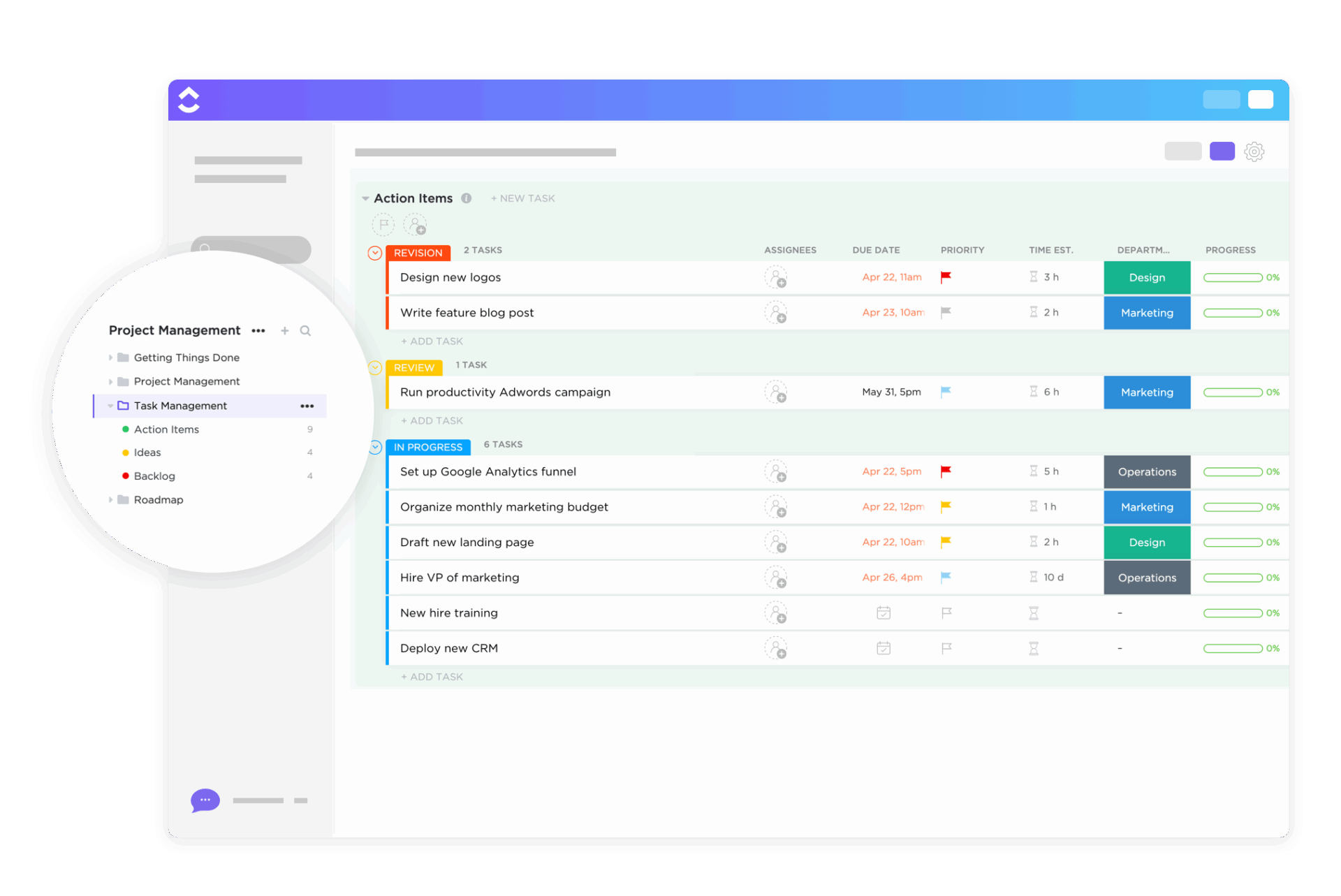
Sorry, there were no results found for “”
Sorry, there were no results found for “”
Sorry, there were no results found for “”

What’s the difference between checking off your to-do list and steering an entire product launch to the finish line? It’s the gap between task management and project management, and it’s bigger than most teams think.
Let’s say you’re launching a new product.
Task management handles the to-dos: writing the press release, designing the landing page, and sending stakeholder emails. It’s execution you can assign and track.
Project management deals with the larger picture. It makes sure those tasks are sequenced correctly and actually support the project progress. That matters because the coordination work is crucial: the U.S. Bureau of Labor Statistics projects about 78,200 openings for project management specialists each year.
In this article, we’ll break down the key differences between project management and task management. We will also cover where they overlap and how the right platform (like ClickUp) helps teams keep day-to-day execution connected to project outcomes.
If your team’s work often gets scattered or stuck, ClickUp’s Task Management Template brings everything into one clear, manageable space.
| Aspects | Task management | Project management |
| Primary focus | Complete individual tasks and follow-ups | Deliver a full initiative and achieve project objectives |
| Scope and structure | Smaller, discrete work items and checklists | Larger scope across phases, workstreams, and deliverables |
| Planning style | Due dates, priorities, and simple ordering | Timelines, milestones, dependencies, and critical path planning |
| Ownership and roles | Individuals or team leads managing tasks | Project manager aligning the project team and multiple stakeholders |
| Tracking and reporting | Task status updates and quick visibility into task completion | Reporting on project progress, risks, and overall project health |
| Resources and workload | Light effort planning across manageable tasks | Resource allocation, workload balancing, and capacity planning |
| Common tools and preferred views | To-do apps, reminders, task views (List/Board/Calendar) | Project boards, Gantt charts, dashboards, project templates |
What needs to be done, who’s doing it, and when it’s due: These are the essential questions that task management refers to.
You’ll find task management everywhere—a designer updating a landing page. A freelancer is responsible for monitoring and responding to client feedback. A manager completes the onboarding process for a new employee.
But here’s the thing: task management is rarely a solo effort. As the volume of tasks increases, so does the need for more intelligent systems.
Proper task management focuses on achieving tasks and objectives within a time period. That’s where task management software like ClickUp comes in to help you manage tasks with intention across teams. Here are a few tools and strategies that can help you achieve that:
Most task management starts with a simple to-do app that lets you capture work quickly, split it into smaller steps, and add structure like due dates or priority flags.
Microsoft To Do is a common example of this approach: you can add tasks to lists, break them into steps, and set due dates and reminders so you do not rely on memory alone.
Tools like Todoist and Google Tasks follow a similar pattern, especially for personal or lightweight team to-dos.
📌 Example: ClickUp’s online to-do list and checklists let you format items and link items to assignees or tasks, so a simple list can turn into an actionable workflow when needed.
📖 Also Read: Best All-in-One Software Solutions for Businesses
Reminders are the “safety net” tool for task management: they surface a nudge at the right time, especially for follow-ups, quick personal notes, or admin items that do not need a full task workflow. In tools like Microsoft To Do, reminders are tied directly to tasks so you can get notified at a chosen date and time.
📌 Example: ClickUp Reminders can be set with due dates and recurrence. You can also delegate them, add attachments, and choose how you want to be notified, which is helpful when a reminder becomes a team follow-up instead of a personal note.
📖 Also Read: Free Task Management Templates

ClickUp’s flexible Task Views let you visualize and manage work from different angles: List for priorities, Board for progress, Calendar for deadlines, and Gantt for dependencies. You can pin views, filter by team member, or create personal views for focused tracking.
📌 Example: A creative team might use Board View for reviewing design stages (Concept → Draft → Final), while the same task set can be viewed in Calendar by the marketing lead to align with a product launch.
📖 Also Read: How to Prioritize Tasks at Work
Here’s a quote for you from William Shakespeare’s The Merry Wives of Windsor.
Better three hours too soon than a minute too late.
Sure, Shakespeare might not have managed product launches or led a remote team, but his wisdom hits close to home for project managers.
In simple terms, it’s the process of planning, organizing, and managing resources to meet a clear set of project goals. That could be planning a product release or even organizing a company offsite.
📌 Example: Your team is preparing for a big campaign launch. You need the creatives from marketing, the data from analytics, the green light from legal, and the product tweaks from engineering. That’s not just task management. That’s project management. And without it, chaos usually gets there before results do.
And it involves a bit of everything: timelines, reporting, team coordination, resource allocation, and, most importantly, clarity.
Fortunately, you don’t have to bear the burden alone. Free project management software like ClickUp brings structure and breathing room to your project workflows with its features.
Project boards (often Kanban-style) help teams visualize work as it moves through stages using cards and columns. This makes it easier to spot bottlenecks and keep work-in-progress under control.
In project management, boards are useful for stakeholder alignment because they make the current state of delivery easy to understand at a glance, especially in cross-functional work, where handoffs and approvals can slow things down.
You’ll see this style of planning in tools like Trello, Jira, Asana, and monday.com, where teams map stages such as “Planned → In progress → Review → Done.”
📌 Example: You can add a ClickUp Kanban Board View to a List or project to track status and move work forward with drag-and-drop updates. If you start with brainstorming, ClickUp Whiteboards can help you turn ideas into execution by converting shapes or sticky notes into tasks and placing tasks or Docs directly on the canvas.
📖 Also Read: How to Use AI to Automate Tasks
A Gantt chart is a timeline view that displays tasks over time, typically as bars, so you can understand what needs to happen when and how long each phase might take.
It’s helpful in project management when work has dependencies (one task cannot start until another is completed), as it helps you map the order of work and understand which tasks will affect the schedule.
Many project management tools support this style of scheduling, including Microsoft Project and Smartsheet.
📌 Example: ClickUp Gantt Chart View lets teams visualize projects as timelines, track dependencies, and monitor progress so delays are easier to see early.
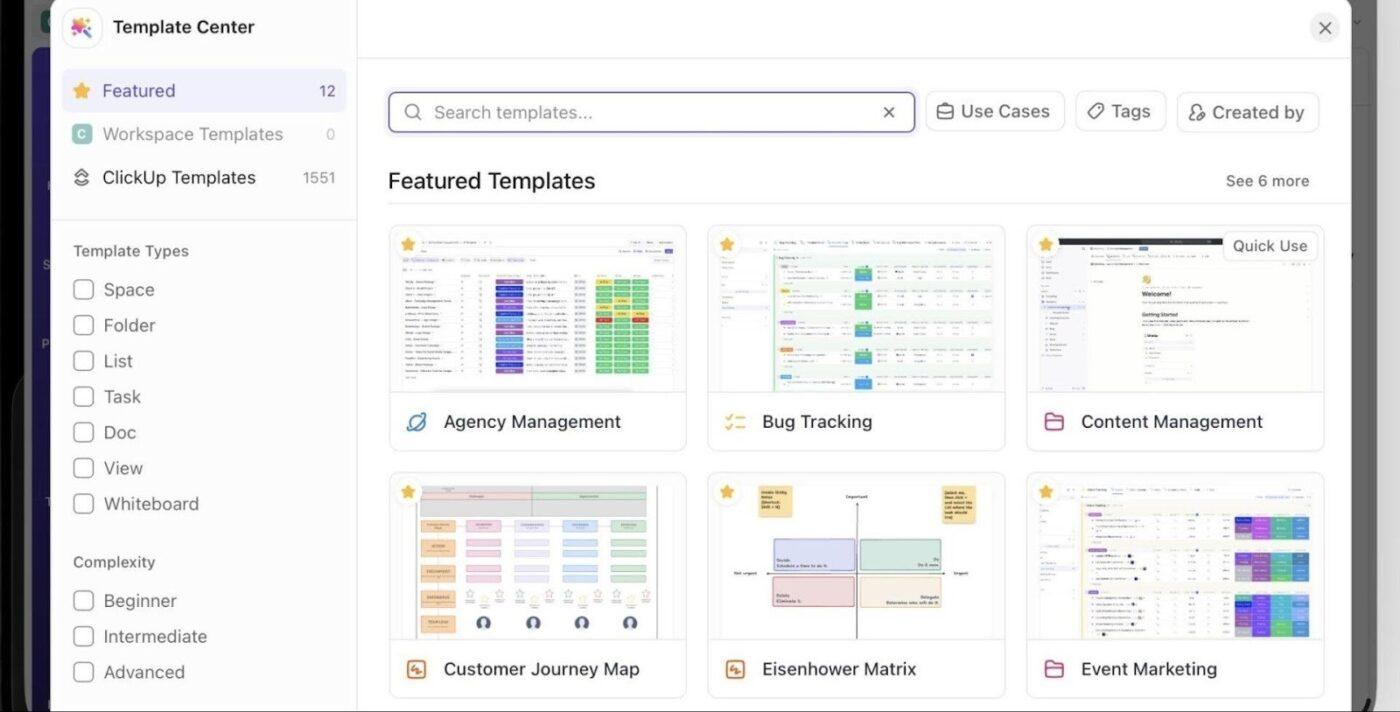
Not every project needs to start from scratch. ClickUp offers over 1000 ready-made templates that cover everything from product launches to content calendars. Each one includes best practices, task structures, and helpful views built in.
📌 Example: A marketing agency can use ClickUp’s Integrated Campaign Template to plan out deliverables and measure campaign success without having to rebuild the process every time.
👀 Fun Fact: The term “deadline” was reportedly first used in Civil War prison camps, where crossing a literal line meant fatal consequences. Thankfully, today, missing one only means a tough meeting.
At first glance, managing a project and a task can seem pretty similar. But once you look a little closer, the differences become clear.
One zooms in on the work that needs doing right now, while the other steps back to see how everything fits together.
Let’s break them down:
Task management is about executing individual tasks: discrete, actionable pieces of work. Think “send client invoice,” “update blog copy,” or “review design draft.” It’s about tracking work at the micro-level and on time.
Project management, on the other hand, defines the entire scope of work needed to meet a specific business objective.
Whether you’re launching a new product or planning a hiring campaign, project management includes the what, why, when, and how of the whole initiative, from kickoff to delivery.
📌 Example: A content writer might be responsible for writing five articles in a week; that’s task management. But how about planning the entire Q4 content calendar, aligning it with SEO strategy, and reporting outcomes? That’s project management in action.
Task management is typically low in complexity. Tasks often operate independently and can be tracked using simple tools such as checklists, calendars, or daily work dashboards.
Project management handles a higher degree of complexity. Projects often include multiple phases, cross-functional teams, deadlines, and risks. Managing all of that means dealing with dependencies and scope creep.
📌 Example: A team lead uses ClickUp to assign subtasks for a campaign: designs, copy, outreach, and feedback. But the campaign itself involves managing budgets, aligning with the sales cycle, and presenting updates to leadership. That’s the higher-stakes orchestration that falls under project management.
📮 ClickUp Insight: Only 30% of workers follow fixed hours, while 27% often work overtime, and 19% have no set schedule. When work keeps shifting, disconnecting becomes difficult.
ClickUp Calendar brings structure to chaotic routines with automated task scheduling. Block focused hours, set boundaries, and get reminders to step away.
💫 Real Results: Lulu Press saves 1 hour daily per employee with ClickUp Automations, boosting overall efficiency by 12%.
In task management, planning is about due dates, priorities, and clear ownership. It’s typically straightforward: “This task is due Tuesday, and Alex is handling it.”
In project management, planning is layered. You’re mapping dependencies (Task B can’t start until Task A is done), identifying critical paths, and keeping milestones aligned with stakeholder expectations.
Project managers must also anticipate risks and reallocate resources as priorities shift.
📌 Example: In a product launch, the UI/UX review must happen before development starts. That dependency is tracked on a Gantt chart in ClickUp. If the review is delayed, the timeline auto-adjusts—and everyone affected is notified. That’s project-level planning.
📖 Also Read: Free Project Communication Plan Templates
Anyone on the team can handle task management. Team leads and individual contributors often self-manage their task lists, relying on tools like ClickUp’s Reminders or List View to stay organized.
Project management typically requires a dedicated role, such as a project manager or program manager. Their responsibilities include coordinating across departments, aligning with stakeholders, managing scope, and guaranteeing the project’s timely delivery.
👀 Fun Fact: NASA’s Apollo program involved over 400,000 people and thousands of tasks. Each deliverable was planned, tracked, and reviewed—arguably the most high-stakes project ever managed.
The tools we use shape how we work. Nowhere is that more obvious than when comparing task management with project management. Task managers need clarity and simplicity.
Daily actions, such as what’s due today, who’s responsible, and how close things are to completion, form the core of their work.
That’s where ClickUp’s Task Checklists shine. They allow you to break a task into smaller subtasks, assign them to teammates, and even create templates for repeatable workflows.
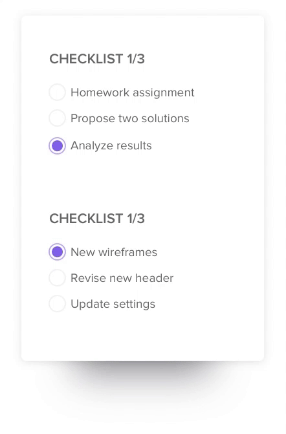
For those who think in columns and rows, ClickUp’s List View gives a clean overview of everything you or your team are working on.
And when timing is key, ClickUp Calendar brings it all together. It lets you visually organize tasks by day, week, or month. For task management, it’s excellent for scheduling deadlines and blocking time for focused work.
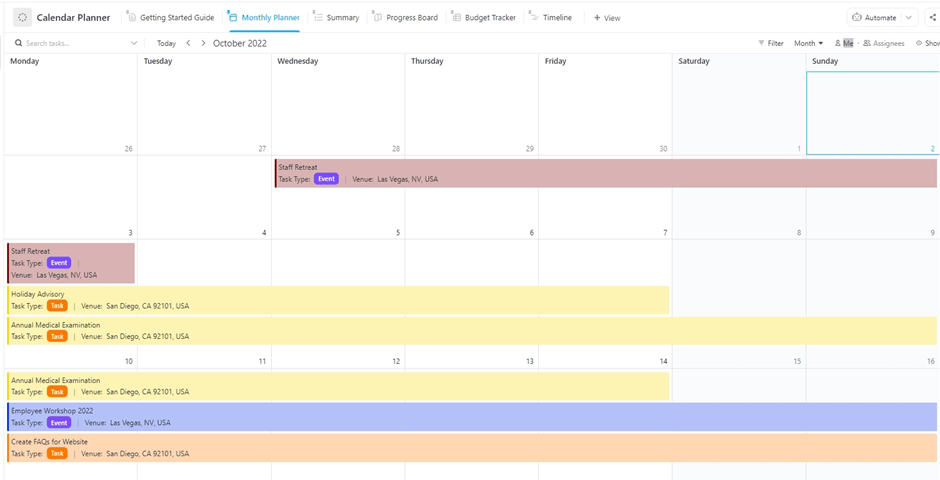
Project management, however, requires a different toolkit: one that can handle scale, timelines, and multiple teams working toward a shared goal. That’s where project management tools like ClickUp’s Kanban boards come in to help you see how work is progressing across phases.
For more structured plans with defined start and end dates, ClickUp’s Gantt Charts offer the visibility project managers need.
📖 Also Read: How to Write Project Documentation
Balancing the big picture with daily execution is what turns good teams into great ones. And that’s only possible when project management and task management work hand in hand.
💡 Pro Tip: Use ClickUp Automations to bridge the gap between task execution and project oversight. Set up rules that automatically update project status when tasks are completed, notify stakeholders when milestones are hit, or reassign work when deadlines shift. This keeps your project view accurate without manual updates—and frees your team to focus on the work itself.
👀 Fun Fact: Great chefs run kitchens like project managers. The French kitchen brigade system is basically project management with knives. There’s a head, a timeline, prep lists, and a strict order of operations. Yes, that’s mise en place in action.
One of the biggest challenges teams face is using separate tools for task and project management. When conversations, files, and updates are scattered across different platforms, work becomes fragmented, and naturally, the effort doubles. The result is work sprawl, and it costs companies time and money.
ClickUp solves this issue by being a converged AI workspace that brings all tools, features, and platforms together. It’s a true “everything app for work” that handles both task details and project complexity seamlessly.
We’ve already explored some of ClickUp’s features. Now let’s look at how they actually play out in real scenarios.
Some days, work feels like a long list of things you’re trying to remember. A client is awaiting a file, a colleague requires feedback, and there’s a minor yet pressing update that you promised to complete before lunch.
That’s where ClickUp steps in.
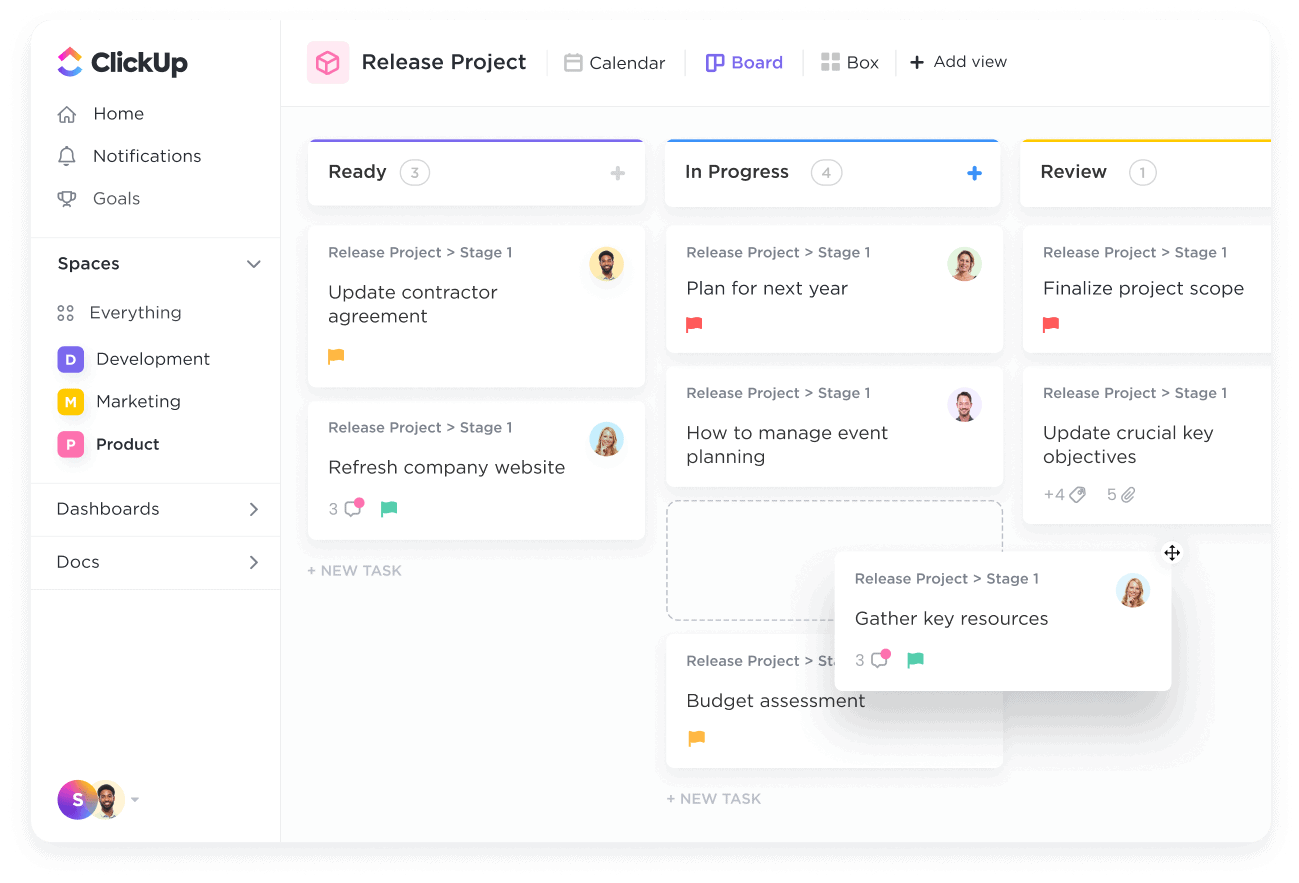
With ClickUp Tasks, you can assign owners, set start and due dates, and keep task details consistent across web and mobile.
To keep execution realistic when multiple tasks pile up, you can also add:
📽️ Here’s a video that carefully explains how you can prioritize tasks to never miss a deadline:
💡 Pro Tip: When you’re responsible for multiple tasks across a team, the slow part isn’t the work; it’s figuring out what changed since yesterday. ClickUp Brain is built to generate task summaries, progress updates, and action items, so you can get to decisions faster.
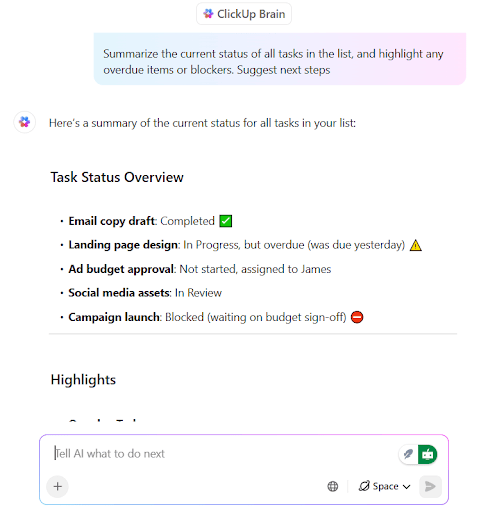
Here are some practical ways you can use ClickUp Brain for task management:
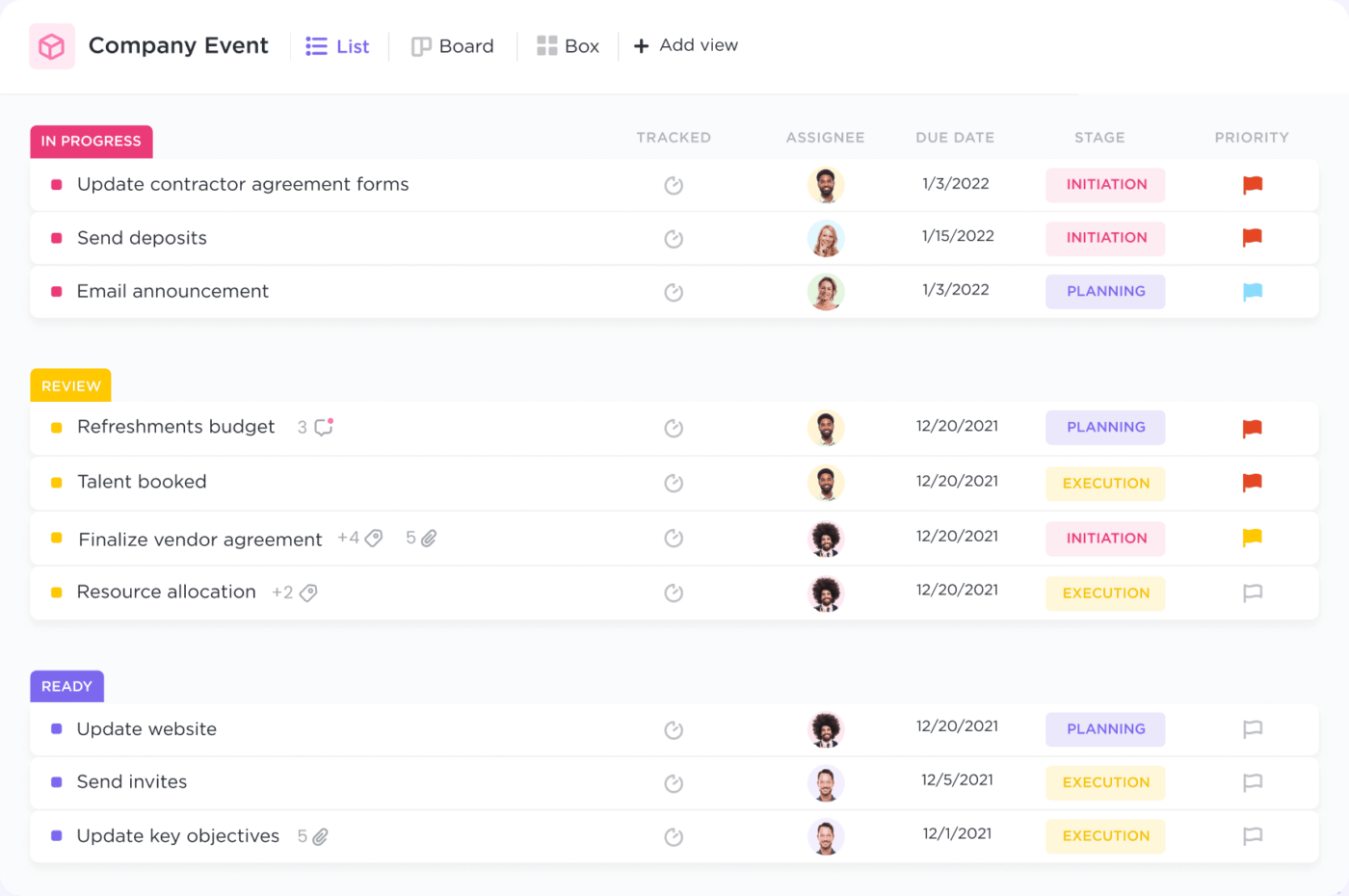
ClickUp Views lets you track individual tasks in multiple views, so each role can stay focused without losing visibility. You can see tasks in List, Board, or ClickUp Calendar, depending on what you are planning.
If you want to get started right away with your task management, ClickUp’s Task Management Template is built for teams that have a lot moving at once.
Here’s why you’ll like this template:
📖 Also Read: Best Digital Workplace Software for Modern Teams
Similar to tasks, project management teams using ClickUp experience a 360-degree view, including what’s on track, what’s falling behind, and what’s blocking the rest.

Projects need more than “what is due next.” They need sequencing, critical paths, and visibility into what slips will break downstream work.
ClickUp’s Gantt charts are designed to map task relationships, spot critical paths, and reduce cascading delays. You can create Gantt views at different levels (like Space, Folder, or List) to fit how your project is structured.
For major moments, you can also turn tasks into ClickUp Milestones to mark key accomplishments (like shipping a feature or hitting a launch gate).

ClickUp Docs is where the project plan lives while the work happens. You can draft a brief or decision log, collaborate in real time, and turn key lines into owned follow-ups. This helps ensure that essential updates don’t stay in silos across different apps.
You can then make your outcomes measurable by connecting your project goals directly to the tasks your team is already doing.
Finally, keep resourcing realistic by tying “work” to time and capacity.
ClickUp supports time estimates on tasks to set expectations. It also has global time tracking from desktop, mobile, or browser to capture actuals and time reporting so you can review where effort went (including billable time if that matters for your team).
Once you have estimates and actuals, ClickUp’s Workload view helps you visualize team capacity by day, week, or month and set capacity limits so you can rebalance assignments before the timeline gets squeezed.
📖 Also Read: How to Optimize Your Internal Knowledge Base for Employee Productivity and Project Management Success
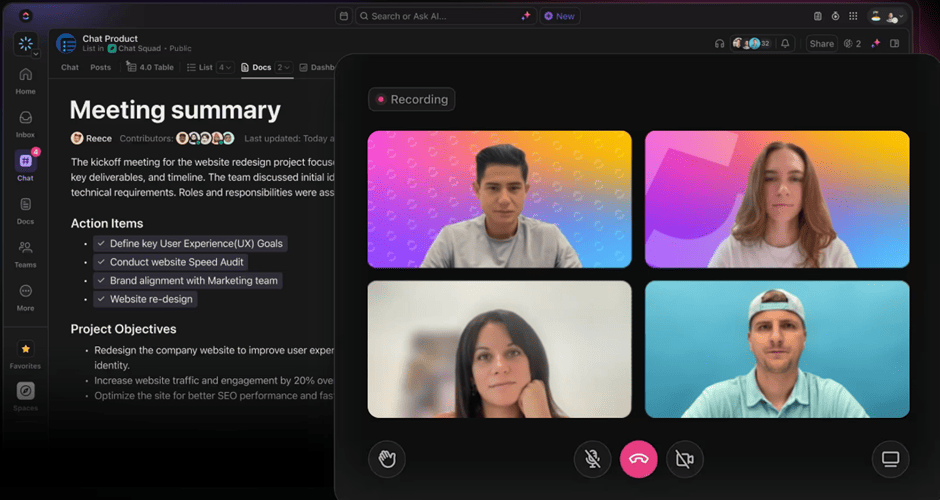
For review cycles, ClickUp’s Assign Comments makes sure feedback is not just “seen” but actually owned. If a stakeholder drops an approval note or change request, you can assign that comment to a person so it becomes a trackable action item connected to the exact task or doc it came from.
Once you’ve established the plan, ClickUp Chat is the ideal platform for maintaining daily coordination within the project.
When a conversation turns into work, you can spin it into a task right from ClickUp Chat and use thread summaries to catch up fast before standups or stakeholder check-ins.
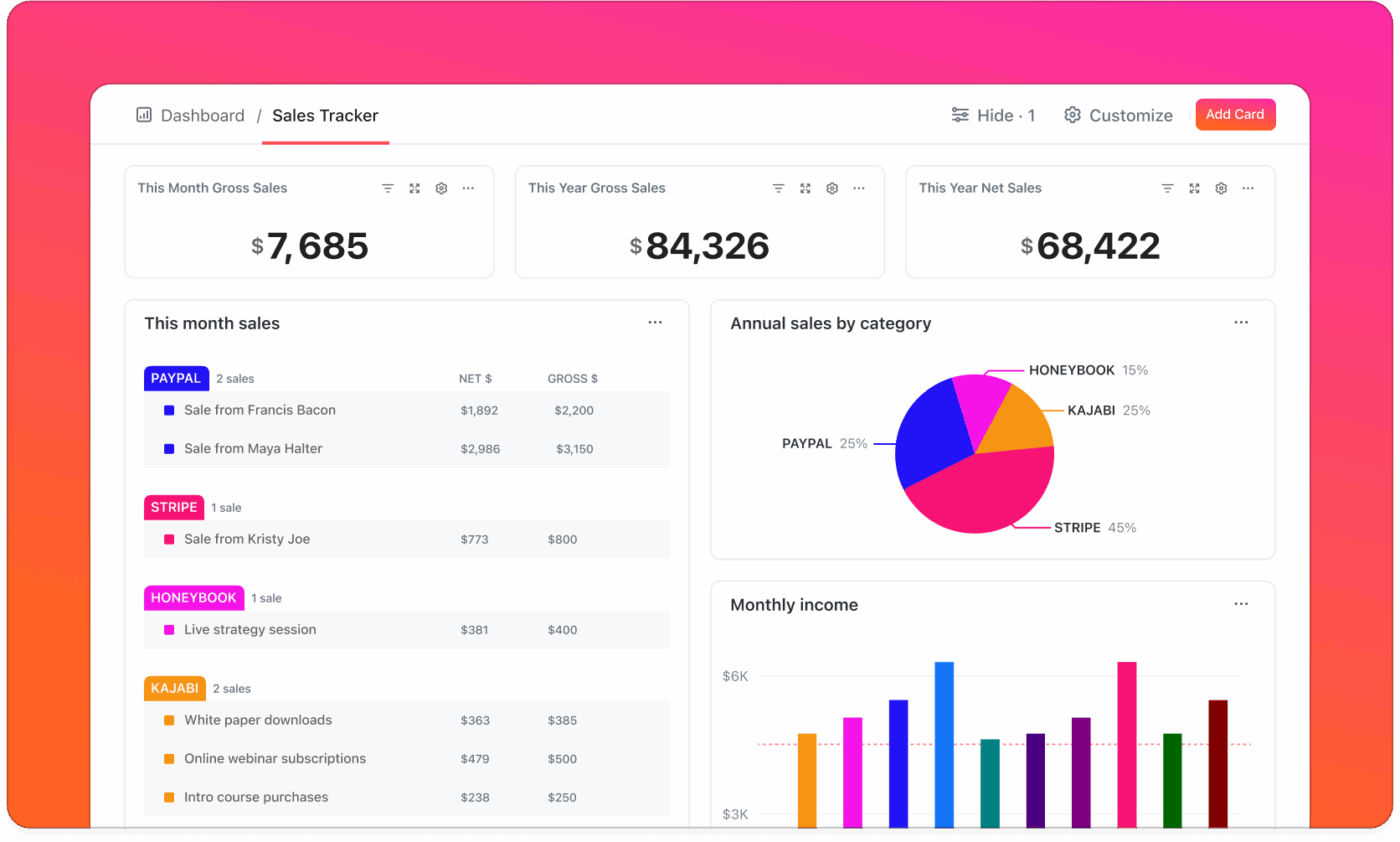
And when there’s a need to report back, ClickUp Dashboards make it easy. You can track campaign progress, team workloads, or billable hours and customize what’s shown based on who’s looking.
If you’re looking for an easy way to get into project management, you can also try out ClickUp’s Project Management Template.
This is what the project management template offers:
💡 Pro Tip: When managing projects, the slow part is often finding the latest context across tasks, documents, and connected files, then turning it into a clean update.
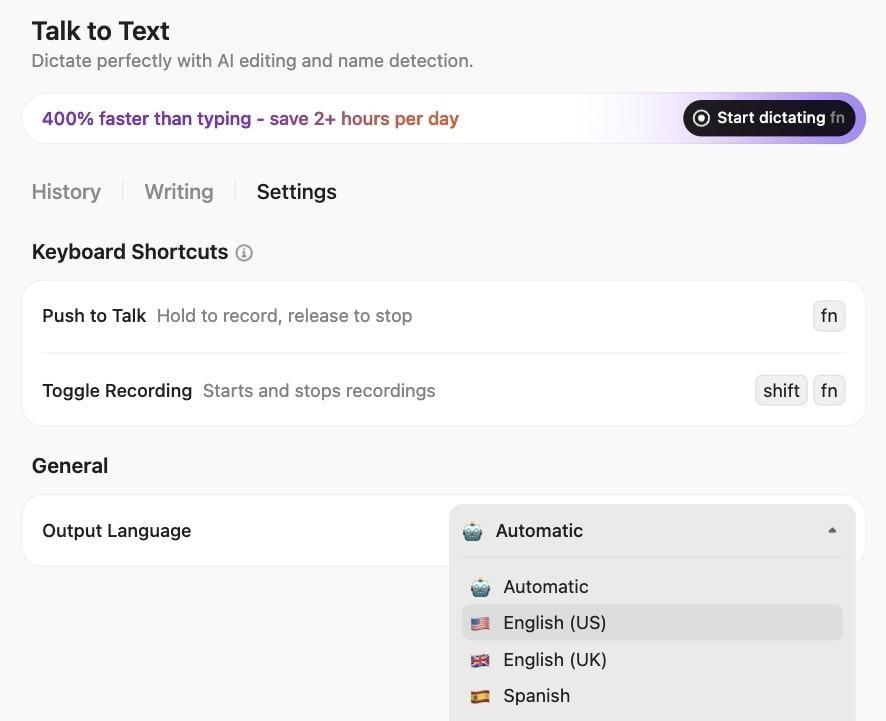
With ClickUp BrainGPT (desktop companion or Chrome extension), you can search across ClickUp, the web, and files from connected apps, then turn results into actions while you work.
Ways to use it in a project management workflow:
Knowing when to use project management vs. task management saves you lots of rework. While some of it is intuitive, here are some examples:
✅ Use the right project management software when:
✅ Meanwhile, task management software offers:
While projects and tasks may appear similar, comprehending their distinctions enables your team to maintain a competitive edge.
Whether you’re planning a multi-phase product launch or checking off your daily to-dos, the real productivity boost comes from knowing when to zoom out and when to drill in.
ClickUp brings both worlds into one place. You get the structure of the best project management software with the flexibility of task tracking and resource management, which helps you achieve project objectives and daily tasks.
From Gantt charts and Docs to reminders and dashboards, ClickUp helps every role stay on top of what matters. See how your project team works better when everything’s in one place by signing up for ClickUp today!
Task management focuses on individual to-dos—discrete, actionable items with clear owners and due dates. Project management takes a broader view, coordinating multiple tasks, teams, timelines, and resources to achieve a larger business objective. Think of task management as the “what needs to be done today” and project management as “how everything fits together to reach the finish line.”
You can, but you’ll likely hit limitations. Basic task management tools work well for simple workflows and small teams. However, as complexity grows—multiple dependencies, cross-functional collaboration, resource allocation—you’ll need project management capabilities like Gantt charts, milestones, and workload views. Platforms like ClickUp offer both, so you don’t have to choose.
The best tool is one that combines task-level execution with project-level visibility in a single platform. ClickUp is designed for exactly this—you can manage daily to-dos with Tasks, Reminders, and Checklists while also planning initiatives with Gantt charts, Dashboards, and Goals. This eliminates the need to switch between separate apps, keeping your team aligned from daily tasks to big-picture outcomes.
If your work involves multiple people, phases, or dependencies—or if missing one deadline affects others—you’ve outgrown pure task management. Signs you need project management include: juggling work across teams, tracking progress toward a larger goal, managing resources or budgets, and reporting to stakeholders. When “checking off to-dos” isn’t enough to keep things on track, it’s time to level up.
© 2025 ClickUp